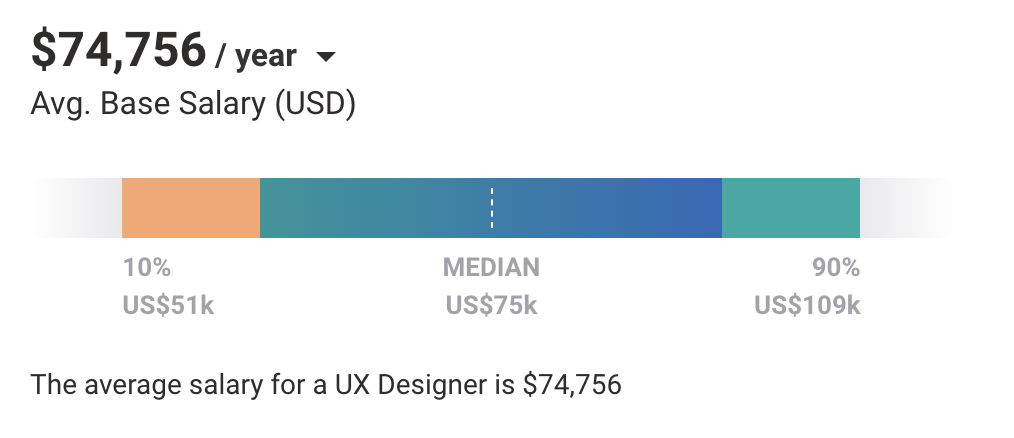6 In-Demand UX Jobs in 2023—and How You Can Get Them

In this article
COVID-19 impacted the software industry unlike any other. Social distancing and restricted movements forced a vast majority of tasks performed in-person to be done online/remotely. This accelerated the growth of the software industry in two distinct ways: New software was being created, and existing software was rapidly improved.
For instance, before the pandemic, several processes in the financial services industry needed a physical signature. When this became almost impossible, regulations were loosened, and organizations created new products to take user signatures securely online. On the other hand, video conferencing products like Teams or GoToMeeting had complex user interfaces designed only for superusers. The pandemic made such tools mainstream, giving relatively newer products like Zoom the edge.
From grocery shopping and stress management to speaking to their grandchildren, digital applications have become a big part of everyday lives. People more willingly adopt products that are easy to use, quick to respond, and enjoyable to interact with.

As a result, thoughtful user experience design has become significant in building products. Product leaders are realizing the direct impact of great UX on revenue; more so since Google announced that it would favor websites with good UX in its search rankings. This means that they are building UX teams with both specialists and generalists, for better overall user experience design.
In this blog post, we’ll explore how you can join one of these teams. We’ll discuss the top careers available in UX design and offer suggestions on how you can find one.
6 In-Demand UX Jobs

The US Bureau of Labour Statistics predicts that jobs for UX designers will grow at 8%—much faster than average. It is also one of the best-paid jobs in the country, with UX designers earning a median salary of $75,000 and 10% of designers earning more than $109,000. A survey finds that 84% of product designers had a salary increase in the last 1-2 years, and they expect a 20% hike in the next 1-2 years.

However, not all UX designer jobs are the same. Within the field of UX design, there is a wide range of jobs, each offering different opportunities, challenges, and growth paths. Some of the most common ones are as follows.
1. UX Designer
A user experience designer is a quintessential generalist, taking responsibility for the entire process from understanding user behavior to execution and testing. The UX designer job description includes UX research, problem definition, information architecture, interface design, interaction design, wireframing, prototyping, user testing, etc. One person performs such a wide range of tasks, typically in a startup or a small business. As the organization and the design team grow, each team member takes on a specific role, specializing in that area.
Skills of a UX designer
The commonly expected UX design skills are:
- Design thinking, user empathy, UX research, ideation, etc.
- Creating information architecture, wireframes, prototypes, user journeys, user flows, etc.
- UI design, brand design, visual design, interaction design, etc.
- Collaboration, communication, etc., along with the ability to transfer the idea effectively to development teams
- Knowledge of top UX design tools such as Figma, Invision, Sketch, Balsamiq, etc.
UX designer salaries
According to Payscale, a UX designer with less than a year of experience earns around $63,706 per year. This grows to over $100,000 with experience. Organizations such as Google, Amazon, Microsoft, Facebook, and Cisco have open UX designer positions today.
2. UX Researcher
As the name suggests, a user experience researcher specializes in research. Their job is about understanding the user, their needs, problems, priorities, and interaction with the product under design. They use qualitative and quantitative research methods to analyze, observe and interview users to inform their design.
One part anthropologist, one part sociologist, and one part marketer, a UX researcher sets the foundation for the user empathy the UX teams need to make design decisions. While most of their work might be stacked before the design begins, they also play a significant role in validating and optimizing designs through testing.
Skills of a UX researcher
A UX researcher is expected to be skilled in:
- User research methods such as thematic analysis, affinity maps, empathy maps, personas, jobs to be done, etc.
- Behavioral psychology and its methods
- Research planning and execution through recruiting users through screener surveys, diary studies, and interviews
- Analysis and interpretation of research data
- Presentations including usability findings, test reports, and so on
UX researcher salaries
The average UX researcher salary is $87,701, going up to $132,000 with seniority levels. PayPal, Instagram, Spotify, Macy’s, etc., have open UX researcher positions.
3. Product Designer
A product designer is a combination of a UX designer and a product manager. They focus on the vision for the product in the long term, leveraging UX techniques for product design. From Hulu’s product designer job description below, you’ll see that the role is more strategic in defining the direction of the product. Therefore, it is also often a senior role, leading a team of UX designers.
Skills of a product designer
In addition to the UX design skills that we discussed above, a product designer is also skilled in:
- Cross-channel design including augmented reality, virtual reality, wearables, etc.
- Communication and leadership
- Process design, continuous integration/continuous deployment (CI/CD) processes
Product designer salary
The average salary for a product designer is $84,785, going up to over $100,000 with experience. As product-driven software development grows, the demand for product designers is expected to increase. Disney, TikTok, Tinder, Quora, etc., are all hiring product designers today.
4. User Interface Designer
A user interface (UI) designer—also known as a graphic designer or visual designer—is responsible for what meets the eye. In many ways, their work is the first thing the user sees, often having a disproportionate impact on the perception of user experience. They create graphics, icons, interactions, and illustrations. They are also often responsible for accessibility and ethical design.
Skills of a user interface designer
- Strong grasp of design principles such as colors, balance, contrast, typography, etc.
- Understanding of the latest design trends
- Experience with tools such as Adobe Photoshop, Illustrator, Sketch, etc.
- Collaboration, iteration, and feedback
- UX writing and copywriting
- Brand design, including logos, brand palettes, style guides, etc.
User interface designer salary
The average salary of a visual designer is $65,631, going up to $93,000 with experience. Many UX designers start their careers as graphic designers and gain experience over time, making it the first step in their growth path. Others focus on areas such as interaction design or animation, building a super-specialized skillset. Figma, Google, Amazon, and Microsoft are a few of the hundreds of companies hiring visual designers right now.
5. UX Writer/Strategist
Of all the UX design jobs, this is the one that’s not seen as design-related. However, in user experience, copy is design. The text that goes on any product contributes significantly to the user experience. This is not just the menu item or banner copy, but also the instructions for various functionalities, error messages, an effortless customer journey, etc.
Skills of a UX writer
- Understanding of the user experience design process
- Ability to write clearly and concisely
- Knowledge of user personas to ensure clarity
- Following guidelines and style guides
- Collaborating with marketing and legal teams to ensure alignment with company goals
UX writer salary
Today, much of the UX writing is done by UX designers or UI designers themselves. In some organizations, content strategists from technical writing or marketing teams might pitch in. Therefore, the salaries are in the same range — $48,073 to $61,200 on average. However, the field is rapidly growing. Amazon, Netflix, Square, Cleo, etc., are hiring UX writers currently.
6. UX Unicorn
In the tech world, ‘unicorn’ refers to someone who possesses more skills than required for any single role. They’re unicorns not only because they’re rare but also because their value to the business is significant.
Skills of a UX unicorn
A UX unicorn is skilled in design and front-end development. In addition to everything that a designer does, UX Unicorns transform their designs to live code and launch them. They have skills in:
- HTML, CSS, and JavaScript
- UI frameworks such as React Native, React, and other OSS frameworks and libraries
- Cross-platform development, including web, mobile, augmented reality, virtual reality, etc.
- CI/CD and DevOps processes
- Data frameworks would be a huge plus!
The skills of a UX unicorn are so rare that you can demand a much higher salary than an average designer or even a specialist.
Get To Know Other Design Students
Nicky Arthur
UX Designer at International Baccalaureate
Trevor Tillery
Experience Designer at Nerdery
Asel Yaşacan
Product Designer at Capital One
How To Get a UX Design Job
As a rapidly growing field, the number of jobs available is much more than the number of qualified candidates applying for the job. With a strategic approach, aspirants can get a job in UX design and kickstart their careers.
Step 1: Build a strong foundation
User experience design is a vast, growing field. To start a career in UX design, you need a strong foundation—both theoretical and practical. This should include research, design, branding, testing, etc. The best way to do this is through a good career-focused online program or a bootcamp. Make sure that the program is designed to cover enough ground in the UX design space.
Step 2: Develop the skills
As a practical field, your skills are only as good as your ability to apply them to practice. Create your small UX design projects and practice your skills. Also, learn the top UX tools such as Figma, Sketch, Balsamiq, Adobe Illustrator, etc.
Step 3: Create a portfolio
Once you have the foundation and the skills, you need to demonstrate them. Your portfolio will help you do that.
- Bring together your top projects, demonstrating a wide range of skills
- Use a storyline format to explain your case studies, showing the business problem you solved with your UX design skills
- Ensure to highlight both your hard and soft skills through relevant examples
- Keep your portfolio updated to show that you’re growing
Step 4: Specialize
Being a broad discipline, UX design has a lot to offer. It helps to command top salaries if you can specialize in specific areas. Choose an area that you’re most interested in, and build deep skills in it. Whether it’s UX research, usability testing, product audits, or UX writing, learn one area much better than the others.
Step 5: Prepare for the job search
Being the right person for a job isn’t the same as getting the job. To land your perfect UX design job:
- Devise a job search strategy to be clear about the role and UX job title you want
- Connect with leaders and seniors in the UX community for guidance and mentorships
- Make a great resume highlighting why you’re the best candidate for the role you’re applying to
- Optimize your portfolio to demonstrate your skills
- Gain interview skills, both in-person and through video conferencing
- Learn negotiation skills
Since you’re here…
Are you a future UX designer? Enroll in our UI/UX Bootcamp and join over 10,000 students who have successfully changed careers with us. Want to get wireframing right this second? Check out our free UX learning path today.





